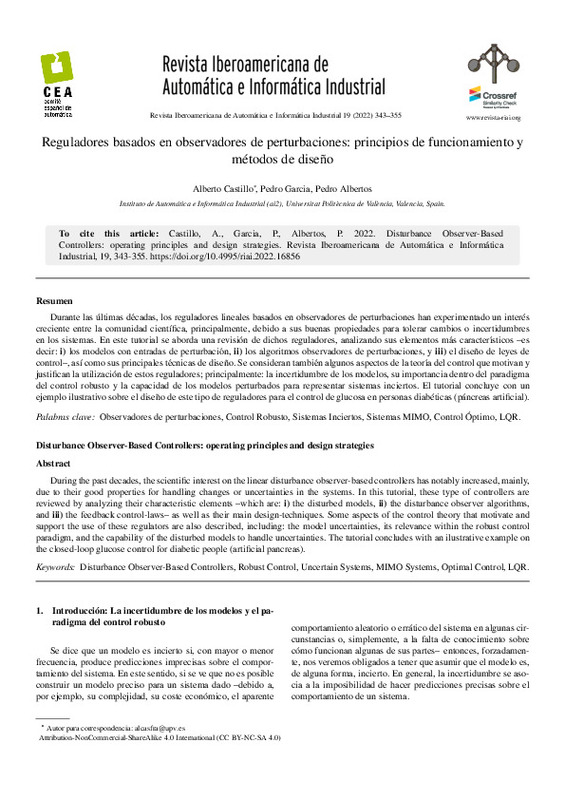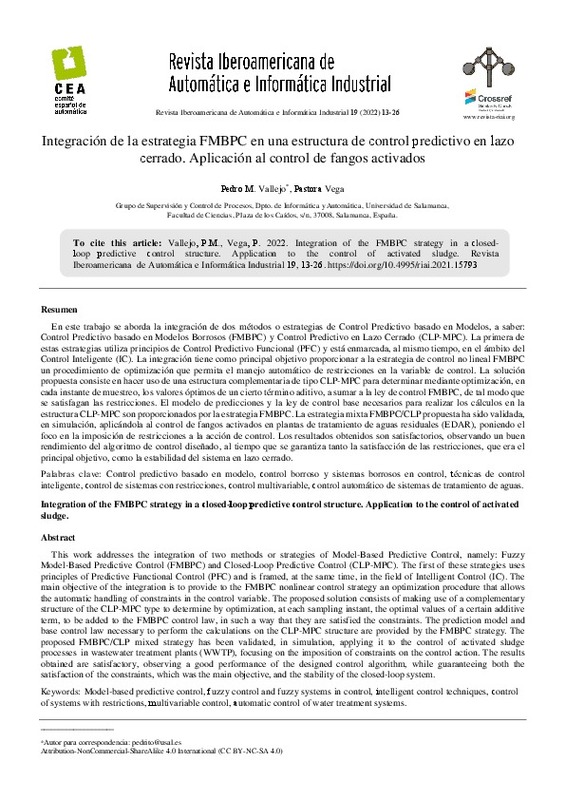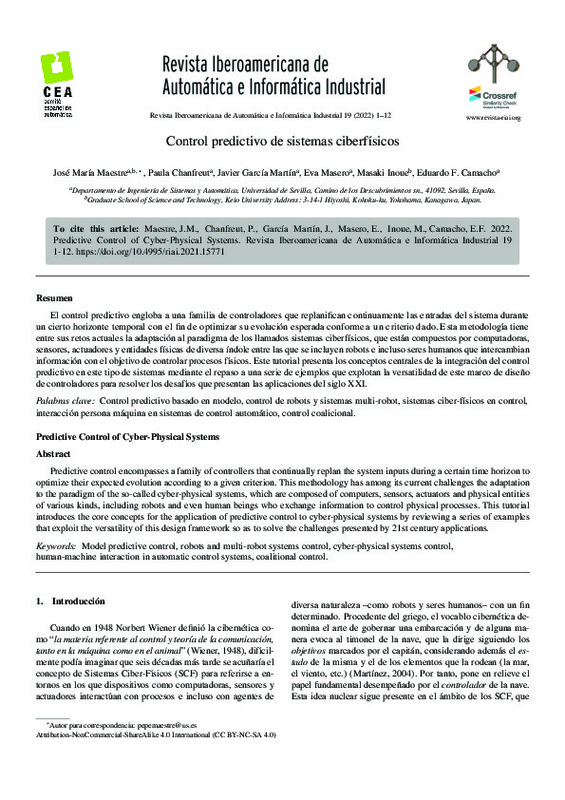Athans, M., 1971. On the LQG problem. IEEE Transactions on Automatic Control 16 (6), 528-528. https://doi.org/10.1109/TAC.1971.1099845
Basar, T., Olsder, G. J., 1998. Dynamic noncooperative game theory. SIAM. https://doi.org/10.1137/1.9781611971132
Bernardi, E., Adam, E. J., 2020. Observer-based fault detection and diagnosis strategy for industrial processes. Journal of the Franklin Institute 357 (14), 10054-10081. https://doi.org/10.1016/j.jfranklin.2020.07.046
[+]
Athans, M., 1971. On the LQG problem. IEEE Transactions on Automatic Control 16 (6), 528-528. https://doi.org/10.1109/TAC.1971.1099845
Basar, T., Olsder, G. J., 1998. Dynamic noncooperative game theory. SIAM. https://doi.org/10.1137/1.9781611971132
Bernardi, E., Adam, E. J., 2020. Observer-based fault detection and diagnosis strategy for industrial processes. Journal of the Franklin Institute 357 (14), 10054-10081. https://doi.org/10.1016/j.jfranklin.2020.07.046
Bernhard, P., 2003. A robust control approach to option pricing. Applications of Robust Decision Theory and Ambiguity in Finance. City University Press, London.
Bhattacharyya, S., 1978. Observer design for linear systems with unknown inputs. IEEE transactions on Automatic Control 23 (3), 483-484. https://doi.org/10.1109/TAC.1978.1101758
Boyd, S., El Ghaoui, L., Feron, E., Balakrishnan, V., 1994. Linear matrix inequalities in system and control theory. SIAM. https://doi.org/10.1137/1.9781611970777
Bünte, T., Odenthal, D., Aksun-G¨uvenc¸, B., G¨uvenc¸, L., 2002. Robust vehicle steering control design based on the disturbance observer. Annual reviews in control 26 (1), 139-149. https://doi.org/10.1016/S1367-5788(02)80024-4
Carvajal, B. V. M., Saez, J. S., Rodríguez, S. G.-N., Iranzo, M. M., 2021. Control por rechazo activo de perturbaciones: guía de dise˜no y aplicación. Revista Iberoamericana de Automática e Informática industrial 18 (3), 201-217. https://doi.org/10.4995/riai.2020.14058
Castillo, A., 2021. Novel strategies to design controllers and state predictors based on disturbance observers. Ph.D. thesis, Universitat Politècnica de València.
Castillo, A., García, P., 2021. Predicting the future state of disturbed lti systems: A solution based on high-order observers. Automatica 124, 109365. https://doi.org/10.1016/j.automatica.2020.109365
Castillo, A., García, P., Fridman, E., Albertos, P., 2019a. Extended state observer-based control for systems with locally lipschitz uncertainties: Lmibased stability conditions. Systems & Control Letters 134. https://doi.org/10.1016/j.sysconle.2019.104526
Castillo, A., García, P., Sanz, R., Albertos, P., 2018. Enhanced extended state observer-based control for systems with mismatched uncertainties and disturbances. ISA transactions 73, 1-10. https://doi.org/10.1016/j.isatra.2017.12.005
Castillo, A., Santos, T. L., Garcia, P., Normey-Rico, J. E., 2020. Predictive esobased control with guaranteed stability for complex uncertain constrained systems. ISA transactions. https://doi.org/10.1016/j.isatra.2020.12.014
Castillo, A., Sanz, R., Garcia, P., Qiu, W., Wang, H., Xu, C., 2019b. Disturbance observer-based quadrotor attitude tracking control for aggressive maneuvers. Control Engineering Practice 82, 14-23. https://doi.org/10.1016/j.conengprac.2018.09.016
Chakrabarty, A., Corless, M. J., Buzzard, G. T., ˙ Zak, S. H., Rundell, A. E., 2017. State and unknown input observers for nonlinear systems with bounded exogenous inputs. IEEE Transactions on Automatic Control 62 (11), 5497-5510. https://doi.org/10.1109/TAC.2017.2681520
Chang, J.-L., 2006. Applying discrete-time proportional integral observers for state and disturbance estimations. IEEE Transactions on Automatic Control 51 (5), 814-818. https://doi.org/10.1109/TAC.2006.875019
Chapellat, H., Bhattacharyya, S., 1989. A generalization of kharitonov's theorem; robust stability of interval plants. IEEE transactions on automatic control 34 (3), 306-311. https://doi.org/10.1109/9.16420
Chen, W. H., Yang, J., Guo, L., Li, S., 2016. Disturbance-observer-based control and related methods-An overview. IEEE Transactions on Industrial Electronics 63 (2), 1083-1095. https://doi.org/10.1109/TIE.2015.2478397
Chilali, M., Gahinet, P., Apkarian, P., 1999. Robust pole placement in LMI regions. IEEE transactions on Automatic Control 44 (12), 2257-2270. https://doi.org/10.1109/9.811208
Choi, B.-K., Choi, C.-H., Lim, H., 1999. Model-based disturbance attenuation for CNC machining centers in cutting process. IEEE/ASME transactions on mechatronics 4 (2), 157-168. https://doi.org/10.1109/3516.769542
Corless, M., Tu, J., 1998. State and input estimation for a class of uncertain systems. Automatica 34 (6), 757-764. https://doi.org/10.1016/S0005-1098(98)00013-2
Deng, J., Xue, W., Zhou, X., Mao, Y., 2020. On disturbance rejection control for inertial stabilization(Cat. No. 01CH37228). Vol. 5. IEEE, pp. 4578-4585.
Doyle, J., Glover, K., Khargonekar, P., Francis, B., 1988. State-space solutionsto standardH2andH∞control problems. In: 1988 American Control Con-ference. IEEE, pp. 1691-1696.
Doyle, J. C., 1978. Guaranteed margins for LQG regulators. IEEE Transactionson automatic Control 23 (4), 756-757. https://doi.org/10.1109/TAC.1978.1101812
Doyle, J. C., Glover, K., Khargonekar, P. P., Francis, B. A., 1989. State-spacesolutions to standard h/sub 2/and h/sub infinity/control problems. IEEETransactions on Automatic Control 34 (8), 831-847. https://doi.org/10.1109/9.29425
Edwards, C., Spurgeon, S., 1998. Sliding mode control: theory and applications.Taylor & Francis. https://doi.org/10.1201/9781498701822
Fernandez-Camacho, E., Bordons-Alba, C., 2013. Model predictive control.Springer science & business media.
Francis, B. A., Wonham, W. M., 1976. The internal model principle of controltheory. Automatica 12 (5), 457-465. https://doi.org/10.1016/0005-1098(76)90006-6
Freeman, R., Kokotovic, P. V., 2008. Robust nonlinear control design: state-space and Lyapunov techniques. Springer Science & Business Media.
Fridman, E., 2014. Introduction to time-delay systems: Analysis and control.Springer. https://doi.org/10.1007/978-3-319-09393-2
Fujimoto, H., Saito, T., Noguchi, T., 2004. Motion stabilization control of elec-tric vehicle under snowy conditions based on yaw-moment observer. In:The 8th IEEE International Workshop on Advanced Motion Control, 2004.AMC'04. IEEE, pp. 35-40.
Gao, N., Darouach, M., Voos, H., Alma, M., 2016. New unifiedH∞dynamicobserver design for linear systems with unknown inputs. Automatica 65,43-52.
Gao, Z., 2006. Active disturbance rejection control: a paradigm shift in feed-back control system design. In: 2006 American control conference. IEEE,pp. 7-pp.
Gao, Z., 2014. On the centrality of disturbance rejection in automatic control.ISA transactions 53 (4), 850-857. https://doi.org/10.1016/j.isatra.2013.09.012
Gao, Z., Huang, Y., Han, J., 2001. An alternative paradigm for control system design. In: Proceedings of the 40th IEEE conference on decision and control (Cat. No. 01CH37228). Vol. 5. IEEE, pp. 4578-4585.
Gao, Z., Wang, H., 2006. Descriptor observer approaches for multivariable sys-tems with measurement noises and application in fault detection and diag-nosis. Systems & Control Letters 55 (4), 304-313. https://doi.org/10.1016/j.sysconle.2005.08.004
Garcia, C. E., Morari, M., 1982. Internal model control. a unifying review and some new results. Industrial & Engineering Chemistry Process Design and Development 21 (2), 308-323. https://doi.org/10.1021/i200017a016
Han, H., Yang, Y., Li, L., Ding, S. X., 2018. Observer-based fault detection for uncertain nonlinear systems. Journal of the Franklin Institute 355 (3), 1278-1295. https://doi.org/10.1016/j.jfranklin.2017.12.021
Han, J., 2009. From pid to active disturbance rejection control. IEEE transactions on Industrial Electronics 56 (3), 900-906. https://doi.org/10.1109/TIE.2008.2011621
Hansen, L. P., Sargent, T. J., 2008. Robustness. Princeton university press. https://doi.org/10.1515/9781400829385
Horowitz, I., 1963. Synthesis of Feedback Systems. Academic Press.
Huang, Y., Xue, W., 2014. Active disturbance rejection control: methodology and theoretical analysis. ISA transactions 53 (4), 963-976. https://doi.org/10.1016/j.isatra.2014.03.003
Jain, S., Yogesh, H., 2020. Generalized active disturbance rejection controller for load frequency control in power systems. IEEE Control Systems Letters 4 (1), 73-78. https://doi.org/10.1109/LCSYS.2019.2923168
Johnson, C., 1971. Accomodation of external disturbances in linear regulator and servomechanism problems. IEEE Transactions on automatic control 16 (6), 635-644. https://doi.org/10.1109/TAC.1971.1099830
Johnson, C. D., 1975. On observers for systems with unknown and inaccessible inputs. International journal of control 21 (5), 825-831. https://doi.org/10.1080/00207177508922036
Johnson, C. D., 1986. Disturbance-accommodating control an overview. In: 1986 American Control Conference. IEEE, pp. 526-536. https://doi.org/10.23919/ACC.1986.4788997
Kadowaki, S., Ohishi, K., Miyashita, I., Yasukawa, S., 2002. Re-adhesion control of electric motor coach based on disturbance observer and sensor-less vector control. In: Proceedings of the Power Conversion Conference-Osaka 2002 (Cat. No. 02TH8579). Vol. 3. IEEE, pp. 1020-1025.
Kanderian, S. S., Weinzimer, S., Voskanyan, G., Steil, G. M., 2009. Identification of intraday metabolic profiles during closed-loop glucose control in individuals with type 1 diabetes. https://doi.org/10.1177/193229680900300508
Kanderian, S. S., Weinzimer, S. A., Steil, G. M., 2012. The identifiable virtual patient model: comparison of simulation and clinical closed-loop study results. Journal of diabetes science and technology 6 (2), 371-379. https://doi.org/10.1177/193229681200600223
Kautsky, J., Nichols, N. K., Van Dooren, P., 1985. Robust pole assignment in linear state feedback. International Journal of control 41 (5), 1129-1155. https://doi.org/10.1080/0020718508961188
Khalil, H. K., Grizzle, J. W., 2002. Nonlinear systems. Vol. 3. Prentice hall Upper Saddle River, NJ.
Khargonekar, P. P., Rotea, M. A., 1991. Mixed H2/H1 control: a convex optimization approach. IEEE Transactions on Automatic Control 36 (7), 824- 837. https://doi.org/10.1109/9.85062
Khlebnikov, M. V., 2016. Control of linear systems subjected to exogenous disturbances: Combined feedback. In: IEEE International Federation of Automatic Control (IFAC). pp. 111-116. https://doi.org/10.1016/j.ifacol.2016.07.936
Kim, K.-S., Rew, K.-H., Kim, S., 2010. Disturbance observer for estimating higher order disturbances in time series expansion. IEEE Transactions on automatic control 55 (8), 1905-1911. https://doi.org/10.1109/TAC.2010.2049522
Li, S., Yang, J., Chen,W. H., Chen, X., 2012. Generalized extended state observer based control for systems with mismatched uncertainties. IEEE Transactions on Industrial Electronics 59 (12), 4792-4802. https://doi.org/10.1109/TIE.2011.2182011
Liu, Z., Liu, J., Wang, L., 2018. Disturbance observer based attitude control for flexible spacecraft with input magnitude and rate constraints. Aerospace Science and Technology 72, 486-492. https://doi.org/10.1016/j.ast.2017.11.036
Mayne, D. Q., 2014. Model predictive control: Recent developments and future promise. Automatica 50 (12), 2967-2986. https://doi.org/10.1016/j.automatica.2014.10.128
Meditch, J., Hostetter, G., 1973. Observers for systems with unknown and inaccessible inputs. In: 1973 IEEE Conference on Decision and Control including the 12th Symposium on Adaptive Processes. IEEE, pp. 120-124. https://doi.org/10.1109/CDC.1973.269143
Mondié, S., Michiels, W., 2003. Finite spectrum assignment of unstable timedelay systems with a safe implementation. IEEE Transactions on Automatic Control 48 (12), 2207-2212. https://doi.org/10.1109/TAC.2003.820147
Mukherjee, S., Bai, H., Chakrabortty, A., 2021. Model-based and model-free designs for an extended continuous-time LQR with exogenous inputs. Systems & Control Letters 154, 104983. https://doi.org/10.1016/j.sysconle.2021.104983
Ohishi, K., 1983. Torque-speed regulation of DC motor based on load torque estimation. In: IEEJ International Power Electronics Conference, IPECTOKYO, 1983-3. Vol. 2. pp. 1209-1216.
Petersen, I. R., Tempo, R., 2014. Robust control of uncertain systems: Classical results and recent developments. Automatica 50 (5), 1315-1335. https://doi.org/10.1016/j.automatica.2014.02.042
Raff, T., Lachner, F., Allgower, F., 2006. A finite time unknown input observer for linear systems. In: 2006 14th Mediterranean Conference on Control and Automation. IEEE, pp. 1-5. https://doi.org/10.1109/MED.2006.328795
Rosenbrock, H., McMorran, P., 1971. Good, bad, or optimal? IEEE Transactions on Automatic Control 16 (6), 552-554. https://doi.org/10.1109/TAC.1971.1099822
Sadhu, S., Ghoshal, T. K., 2010. Sight line rate estimation in missile seeker using disturbance observer-based technique. IEEE Transactions on Control Systems Technology 19 (2), 449-454. https://doi.org/10.1109/TCST.2010.2046662
Safonov, M. G., 1980. Stability and robustness of multivariable feedback systems. MIT press. https://doi.org/10.7551/mitpress/6428.001.0001
Safonov, M. G., 2012. Origins of robust control: Early history and future speculations. Annual Reviews in Control 36 (2), 173-181. https://doi.org/10.1016/j.arcontrol.2012.09.001
Sala-Mira, I., Diez, J.-L., Ricarte, B., Bondia, J., 2019. Sliding-mode disturbance observers for an artificial pancreas without meal announcement. Journal of Process Control 78, 68-77. https://doi.org/10.1016/j.jprocont.2019.03.008
Sandberg, I. W., 1964. A frequency-domain condition for the stability of feedback systems containing a single time-varying nonlinear element. Bell System Technical Journal 43 (4), 1601-1608. https://doi.org/10.1002/j.1538-7305.1964.tb04100.x
Sanz, R., Garcia, P., Albertos, P., 2016. Enhanced disturbance rejection for a predictor-based control of lti systems with input delay. Automatica 72, 205- 208. https://doi.org/10.1016/j.automatica.2016.05.019
Sanz, R., Garc'ıa, P., D'ıez, J.-L., Bondia, J., 2020. Artificial pancreas system with unannounced meals based on a disturbance observer and feedforward compensation. IEEE Transactions on Control Systems Technology 29 (1), 454-460. https://doi.org/10.1109/TCST.2020.2975147
Sanz, R., Garcia, P., Fridman, E., Albertos, P., 2018. Rejection of mismatched disturbances for systems with input delay via a predictive extended state observer. International Journal of Robust and Nonlinear Control 28 (6), 2457- 2467. https://doi.org/10.1002/rnc.4027
Sariyildiz, E., Chen, G., Yu, H., 2015. An acceleration-based robust motion controller design for a novel series elastic actuator. IEEE Transactions on Industrial Electronics 63 (3), 1900-1910. https://doi.org/10.1109/TIE.2015.2512228
Sariyildiz, E., Oboe, R., Ohnishi, K., 2020. Disturbance observer-based robust control and its applications: 35th anniversary overview. IEEE Transactions on Industrial Electronics 67 (3), 2042-2053. https://doi.org/10.1109/TIE.2019.2903752
Scherer, C., Weiland, S., 2000. Linear matrix inequalities in control. Lecture Notes, Dutch Institute for Systems and Control, Delft, The Netherlands 3 (2).
Schweppe, F., 1968. Recursive state estimation: Unknown but bounded errors and system inputs. IEEE Transactions on Automatic Control 13 (1), 22-28. https://doi.org/10.1109/TAC.1968.1098790
She, J.-H., Xin, X., Pan, Y., 2010. Equivalent-input-disturbance approach- analysis and application to disturbance rejection in dual-stage feed drive control system. IEEE/ASME Transactions on Mechatronics 16 (2), 330-340. https://doi.org/10.1109/TMECH.2010.2043258
Stocker, D., Kanderian, S., Cortina, G., Nitzan, T., Plummer, J., Steil, G., Mastrototaro, J., 2006. Virtual patient software system for educating and treating individuals with diabetes.
Su, J., Chen, W.-H., 2018. Further results on "reduced order disturbance observer for discrete-time linear systems". Automatica 93, 550-553. https://doi.org/10.1016/j.automatica.2018.04.032
Ugurlu, B., Nishimura, M., Hyodo, K., Kawanishi, M., Narikiyo, T., 2014. Proof of concept for robot-aided upper limb rehabilitation using disturbance observers. IEEE Transactions on Human-Machine Systems 45 (1), 110-118. https://doi.org/10.1109/THMS.2014.2362816
Umeno, T., Hori, Y., 1991. Robust speed control of DC servomotors using modern two degrees-of-freedom controller design. IEEE Transactions on industrial electronics 38 (5), 363-368. https://doi.org/10.1109/41.97556
Wang, C., Dong, W., Wang, J., Ding, Z., 2020. Predictive descriptor observer design for a class of lti systems with applications to quadrotor trajectory tracking. IEEE Transactions on Industrial Electronics, 10019-10028. https://doi.org/10.1109/TIE.2020.3028803
Wang, H., Daley, S., 1996. Actuator fault diagnosis: an adaptive observer-based technique. IEEE transactions on Automatic Control 41 (7), 1073-1078. https://doi.org/10.1109/9.508919
Wu, A.-G., Duan, G.-R., Fu, Y.-M., 2007. Generalized pid observer design for descriptor linear systems. IEEE Transactions on Systems, Man, and Cybernetics, Part B (Cybernetics) 37 (5), 1390-1395. https://doi.org/10.1109/TSMCB.2007.901205
Wu, Z.-H., Zhou, H.-C., Guo, B.-Z., Deng, F., 2020. Review and new theoretical perspectives on active disturbance rejection control for uncertain finitedimensional and infinite-dimensional systems. Nonlinear Dynamics, 1-25. https://doi.org/10.1007/s11071-020-05845-7
Xiong, Y., Saif, M., 2003. Unknown disturbance inputs estimation based on a state functional observer design. Automatica 39 (8), 1389-1398. https://doi.org/10.1016/S0005-1098(03)00087-6
Yang, J., Zolotas, A., Chen, W.-H., Michail, K., Li, S., 2011. Robust control of nonlinear MAGLEV suspension system with mismatched uncertainties via DOBC approach. ISA transactions 50 (3), 389-396. https://doi.org/10.1016/j.isatra.2011.01.006
Yokoyama, T., Kawamura, A., 1994. Disturbance observer based fully digital controlled PWM inverter for CVCF operation. IEEE Transactions on Power Electronics 9 (5), 473-480. https://doi.org/10.1109/63.321031
Zames, G., 1966. On the input-output stability of time-varying nonlinear feedback systems part one: Conditions derived using concepts of loop gain, conicity, and positivity. IEEE transactions on automatic control 11 (2), 228-238. https://doi.org/10.1109/TAC.1966.1098316
Zhu, Y., Fridman, E., 2021. Sub-predictors for network-based control under uncertain large delays. Automatica 123, 109350. https://doi.org/10.1016/j.automatica.2020.109350
[-]












